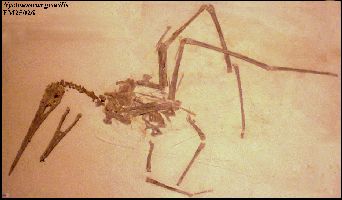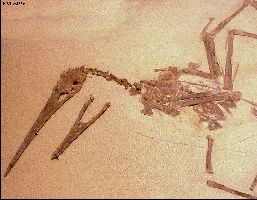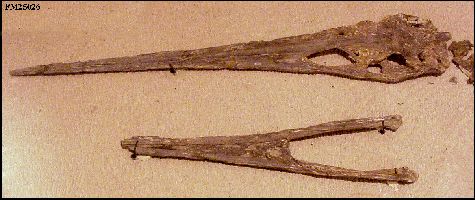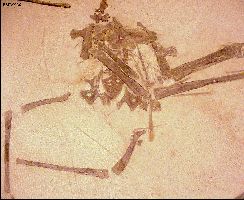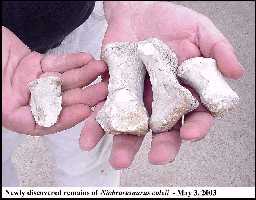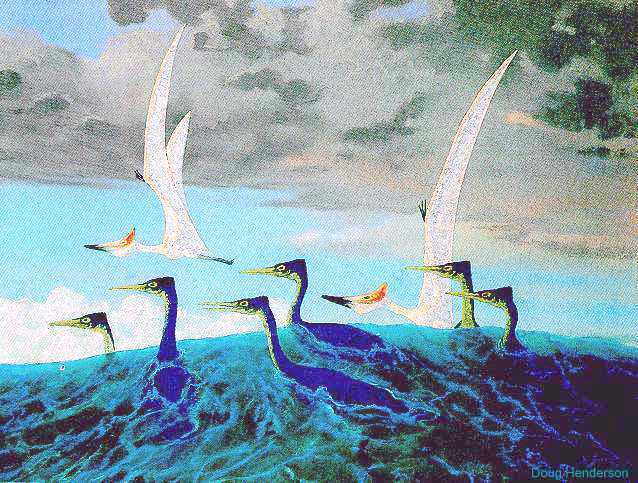 |
A Field Guide to Fossils of the Smoky
Hill Chalk
Part 4: Pteranodons, Birds, and Dinosaurs
Copyright © 2000-2011 by Mike Everhart
Last Updated 01/25/2011
LEFT: Hesperornis and Pteranodon.
Copyright © Doug Henderson; used with permission of Doug Henderson |
Continued from Part 3: Marine
Reptiles
4. Pteranodons
Pteranodons
are a group of flying reptiles that are characteristically toothless and tail-less (they
do have a short tail). The males grew to large size (wingspreads of 7.5 m or
more) during the deposition of the
Smoky Hill chalk (Late Coniacian
to Early Campanian, 87 to 82 mya). Their remains are only known for certain
from Kansas, South Dakota and Wyoming
The wing bones of the first Pteranodon found in North America was
discovered in the Smoky Hill Chalk of western Kansas by O. C. Marsh
in 1870. The only species of pterosaurs that are known to occur in the chalk are the
highly developed Pteranodons and Nyctosaurus.
 |
These flying reptiles do not have teeth or tails like earlier
pterosaurs found in the Jurassic of Europe, and are generally much larger. LEFT:
An old version of the skeleton of Pteranodon longiceps (Wing spread about 20
feet) - Upper Smoky Hill Chalk, Kansas. The wing membranes are no longer considered to
have been connected to the lower legs. |
They were apparently "warm blooded" in some respects,
and may have had a thin covering of hair on their bodies. Pteranodons fed
primarily on fish and squid. Their role in the Late Cretaceous Inland Sea was probably
similar to modern sea birds such as the albatross and pelican, and they may have spent
most of their lives soaring over the ocean looking for food.
 |
Nesting sites are unknown in the fossil record of North America
but it likely that they were hundreds of miles from where their abundant remains are found
in the Smoky Hill Chalk of modern day Kansas. LEFT: The skeleton of Pteranodon
longiceps (lateral view) - Adapted from original drawing by Eaton (1910).
Not the relative size of the huge skull compared to the much smaller body. |
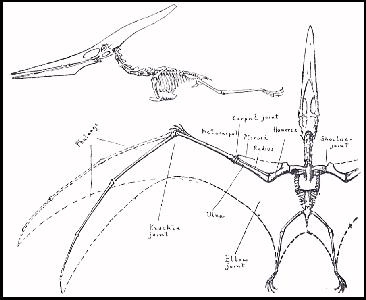 |
LEFT: Another version of Eaton's 1910 drawing of Pteranodon
longiceps. In this case, the figure is an illustration from: Hankin, E. H. and D. M.
S. Watson. 1914. On the flight of Pterodactyls. The Aeronautical Journal, 18: 324-335. Note
the small size of the pteranodon's body compared to the length of the head, and to the
wings. Pteranodons were superbly adapted to flight, including their hollow bones and the
way in which their dorsal vertebrae were fused together with the ribs to form a solid
structure that supported the flight muscles. While they were excellent long distance
flyers, they probably spent more time soaring than flapping their wings. |
A. Pteranodon longiceps: Pteranodons
were first discovered in the upper chalk of Logan County, Kansas by O. C. Marsh in 1870.
The only remains found were fragments of wing bones, but they were recognizable as being
similar to the pterodactyls found in Europe. Marsh named two species from the
remains, Pterodactylus occidentalis and P. ingens. P. longiceps was
named later from a much more complete specimen. It wasn't until about 1876 that the first
skulls were found and it was discovered that these flying reptiles did NOT have teeth and
the name was changed to Pteranodon. It was later realized that nearly all of the
remains were probably from the same species, Pteranodon longiceps.
 |
LEFT: The skull of Pteranodon longiceps (lateral view,
about 4 feet) (From YPM-1177) |
B. Pteranodon sternbergi -
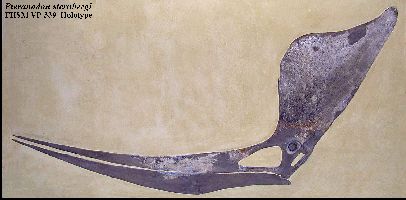 |
LEFT: Type specimen of Pteranodon sternbergi (FHSM VP-339) - A
large pterosaur, with a wing spread of more than 20 feet which is characterized by a
large, upward pointing crest. P. sternbergi is found fairly commonly in the lower
chalk. The first specimen was found by G. F. Sternberg in 1952 in Graham County, KS.
Fossilized pterosaur remains are extremely fragile, but sometimes include wing and toe claws. Pteranodon remains
first occur in the low chalk near Hattin's Marker Unit 5. P. longiceps is a
related species that occurs higher in the chalk. The males of this species have long,
slender crest that extends almost as far behind the skull as the jaw extends to the front!
|
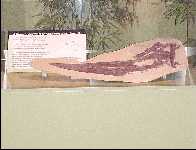 |
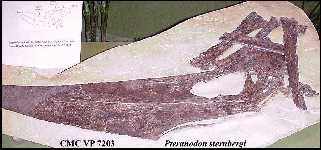 |
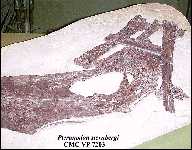 |
LEFT: In 1996, my wife found the wing bones of a large Pteranodon
sternbergi eroding from the edge of a chalk bluff. We recovered the skull and most of
the wings. In 1999, we donated the specimen (CMC VP 7203) to the Cincinnati Museum
Center where it is currently on exhibit. In February, 2003, I visited the museum and
took the pictures shown at left. |
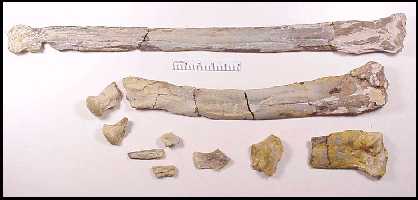 |
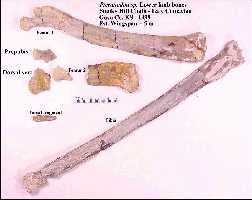 |
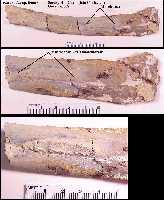 |
LEFT: Here are some pictures of the lower leg bones of a small Pteranodon
that I found several year ago (Also identified by Chris Bennett) |
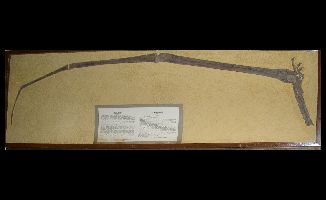 |
LEFT: A nearly complete (lacking the humerus) left wing of a Pteranodon
collected by G. F. Sternberg and exhibited in the Fick Fossil and History Museum in
Oakley, Kansas. RIGHT: Detail of the same wing showing the three digits of the
hand and the cores of the wing claws. |
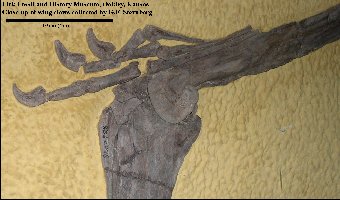 |
C. Nyctosaurus gracilis -
Nyctosaurus was a smaller pterosaur that occurs from the middle of the
chalk upwards. It was first described by O. C. Marsh in 1876.
Other than size, the skeleton differs from P. longiceps most noticeably in the
shape of the humerus (upper wing bone), and in the lack of a crest on the skull.
 |
LEFT: The type specimen of Nyctosaurus bonneri
(FHSM VP-2148) at the Sternberg Museum. Bennett (1994)
considered N. bonneri to be a junior synonym of N. gracilis.
|
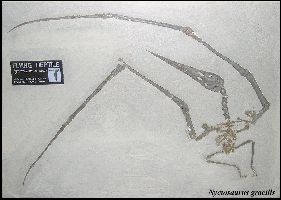 |
LEFT: The nearly complete specimen of a Nyctosaurus
gracilis (UNSM
93000) from the Smoky Hill Chalk of western Kansas on exhibit in the University of
Nebraksa State Museum, Lincoln Nebraska. Found by Greg Brown near Elkader in Logan County.
This specimen shows that Nyctosaurus had three wing phalanges, not four as shown in
Williston's drawing below. |
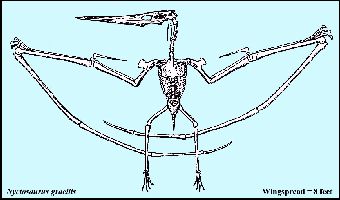 |
LEFT: A drawing of the skeleton of Nyctosaurus gracilis from
Williston's "Osteology of Reptiles" (1925, p. 299, fig. 190). Until
recently, Nyctosaurus was not known to have crests like the larger species of Pteranodon
(see below). |
| The recent discovery in the Smoky Hill Chalk of western Kansas of
two specimens of Nyctosaurus with very large crests is discussed in a paper by
Chris Bennett: Bennett, S. C. 2003. New crested specimens of the
Late Cretaceous pterosaur Nyctosaurus. Paleontologist Zeitschrift, 77:61-75. (Chris Bennett Website)
The extremely large crest (at right) on these small flying reptiles raises
questions about what it was used for and how they were able to fly. |
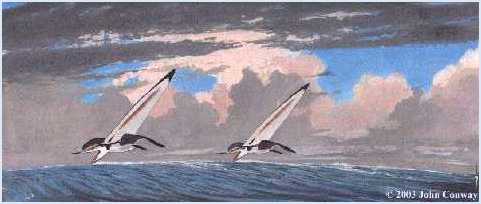 |
"Skimming Nyctosaurs" painting ©
2003 by John Conway. Used with permission of John Conway. (Click on picture to
enlarge) |
D. Toothed Birds
There were several species of primitive birds that flew over and / or swam in
the Western Interior Sea. A major difference between these and modern birds was that they
still had teeth. The bones of Hesperornis are fairly dense and finely grained. Bird remains are
relatively rare in the Smoky Hill Chalk.
| 1. Hesperornithids - Large (5+ ft
in length) flightless birds that swam in the ocean and preyed on small fish much like
modern penguins. Hesperornis remains are rare, and are found only in the upper
chalk (Campanian). Remains of these birds are more common in Cretaceous deposits to the
north of Kansas where the weather / water was probably cooler. You can see the
remains of a Hesperornis preserved as stomach
contents in a large Tylosaurus here. At right: A drawing
of Hesperornis, based on skeletal remains (about 5 feet in length). (Another view HERE) |
 |
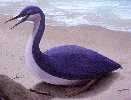 |
Hesperornis regalis was a large (up to 5 feet in
total length) flightless bird (with teeth) that lived in the northern reaches of the
Western Interior Sea. Although the first remains of this bird were found in Kansas
in the 1870s, they are more common further north in Canada.
LEFT: This picture of a nesting Hesperornis
is from the large seashore mural at the Sternberg Museum. RIGHT: A diving Hesperornis
from a large underwater diorama in the Sternberg Museum. |
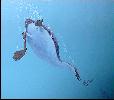 |
| Click on the pictures at right to see portions of the mounted
partial skeleton of Hesperornis regalis (FHSM
VP- 2069) at the Sternberg Museum of Natural history: 1) neck, chest and
hips; 2) hips and upper legs; and 3) left foot. |
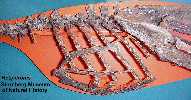 |
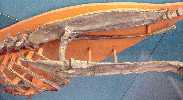 |
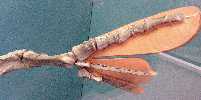 |
2. Baptornithids - Smaller, flightless birds
similar to Hesperornis and found only in the upper chalk.
3. Ichthyornithids -A small, pigeon or
gull-sized bird. Ichthyornis is rare but apparently occurs throughout the chalk.
A partial skeleton of a mounted specimen (FHSM VP-2503) of Ichthyornis is on
exhibit at the Sternberg Museum of Natural History.
Ichthyornis was first found by Professor B.
F. Mudge and described by O. C. Marsh in 1872. Marsh's
restoration of the skeleton is at right; the lower jaw
is here. Here is a picture of the upper end of a Ichthyornis
leg bone (femur). The teeth and manner of replacement was described in:
Marsh, O. C., 1883. Birds with Teeth. 3rd Annual Report of the Secretary of the Interior,
3: 43-88. Government Printing Office, Washington, D.C., page 73:
"In the lower teeth of Ichthyornis, the pulp-cavity passes well up into the
base of the crown. The fang is compressed, and directed downward and forward. It is firmly
set in a deep socket, which it nearly or quite fills. The dental succession took place
vertically, as in Crocodiles and Dinosaurs; not laterally as in Hesperornis and
the Mosasaurs, a fact of no little significance. The young teeth are much inclined when
they first appear above the jaw, after the old teeth have been expelled."RIGHT: Fig. 27, a reconstruction of Ichthyornis
(dispar) victor, from Marsh, 1883. (CLICK TO ENLARGE). |
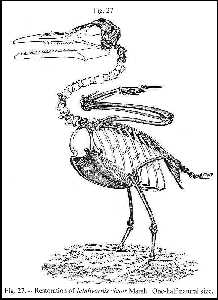 |
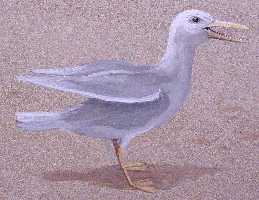 |
At left: A painting of Ichthyornis sp. in the sea shore
mural at the Sternberg Museum of Natural History, based on skeletal remains (about 10
inches). Ichthyornis dispar was a small, gull or tern-like Late Cretaceous
bird with teeth. Ichthyornis was first found by Professor B. F. Mudge and described (without teeth) by O. C. Marsh in 1872. Marsh's
restoration of the skeleton is here; the lower jaw is here. At right: A mounted partial skeleton at
the Sternberg Museum (FHSM VP-2503) found by J.D. Stewart in 1970 (Graham County, near
Bogue, KS). For a photograph of a recently discovered Ichthyornis coracoid
bone, click HERE. |
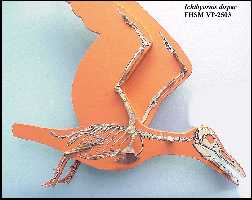 |
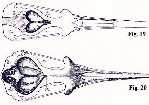 |
Bird brains: In these figures from Marsh's (1883) Birds with
Teeth: (left) the skull and relative brain size of Ichthyornis victor
(Fig.19 ) is compared with the modern Sandwich Tern (Sterna Contac, Fig. 20 );
(right), the skull and relative brain size of Hesperornis regalis (Fig. 7) is
compared with with the modern Loon (Columbus torquatus, Fig. 8). |
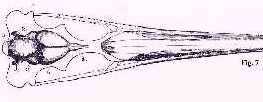 |
E. DINOSAURS:
The Smoky Hill Chalk is about the last place I would have expected to ever find
a dinosaur. Yet the remains of several dinosaurs have been discovered there... the
first of which was found by Professor O. C. Marsh in 1871 in Logan
County.
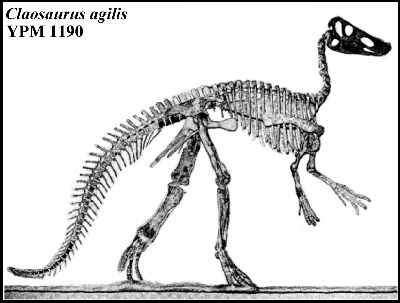 |
LEFT: The mounted type specimen of Claosaurus agilis (YPM
1190) in the Yale Peabody Museum. This specimen is reasonably complete but somewhat
weathered. According to Marsh, he went back to the site at least once to recover
more of the remains. The skull was missing from the remains and is a plaster model in this
mounting. |
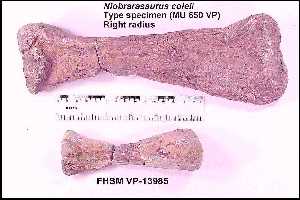
|
Since 1930, two additional partial
nodosaur remains have been found in the Smoky Hill Chalk. The first was specimen
discovered by by J.D. Stewart in Rooks County (1973), and the second was a juvenile limb
found by Shawn Hamm in Lane County in 2000 (pictured).
RIGHT: The right ulna of VP-13985 compared to the type specimen of
Niobrarasaurus coleii.
LEFT: The right radius of VP-13985 compared to the type specimen of
Niobrarasaurus coleii. |
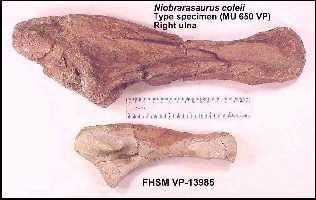 |
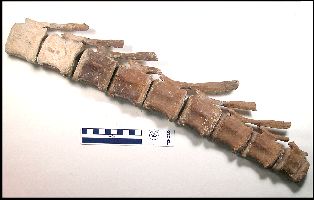 |
LEFT: On June 2, 2005, I was with Keith Ewell when he found what
is only the sixth set of dinosaur remains to be documented from the Smoky Hill Chalk of
western Kansas. The newest dinosaur specimen from the Smoky Hill Chalk consists of nine articulated caudal (tail) vertebrae (FHSM VP-15824) from an
adult hadrosaur. The most anterior (light colored) vertebrae (#1 and #2) of the series had
eroded out and were exposed on the surface of the chalk. The other seven vertebrae were
still completely enclosed in the matrix. The specimen is 22 in (55 cm) in length, and
comes from the distal part of the tail. There are non-serrated bite marks on both sides of
the last vertebrae (#9, see pictures below). The bone surface at both ends of the
articulated series are severely eroded and appear to have been partially digested. |
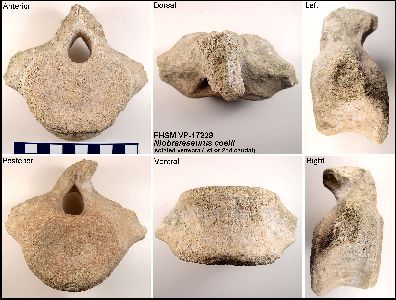 |
EIGHTH DINOSAUR SPECIMEN FOUND IN THE SMOKY HILL CHALK (FHSM
VP-17229) LEFT: Over the Memorial Day weekend in 2007, Laura and Scott
Garrett were prospecting for fossils in the lower Smoky Hill Chalk (below Hattin's Marker
Unit 3 - Late Coniacian) of southwestern Trego County. Laura found an isolated anterior
caudal vertebra (near the base of the tail) from what appears to be a large ankylosaur,
most likely Niobrarasaurus coleii. Note that this vertebra is very
similar to, but much larger than, the one collected by Keith Ewell in 2004 (above). Laura
becomes the first woman (and only the 7th person) to ever collect dinosaur remains from
the Smoky Hill Chalk. The Garretts generously donated the specimen to the Sternberg Museum
of Natural History (VP-17229). The specimen comes from about 6 miles south of the site
where VP-16385 was collected in 2004, and from about 5 miles east of where the type
specimen of Niobrarasaurus coleii (VP- 14855) was collected in 1930. All are Late
Coniacian in age. |
CONTINUE TO PART 5: COPROLITES,
Coprolites, Pearls, Fossilized Wood and other Remains
For additional background information on Kansas geology, Smoky Hill Chalk,
marine fossils of the Late Cretaceous and paleontology in general, see my Late Cretaceous
Marine references about Marine reptiles and Fish and other fossils.
BACK TO INDEX















